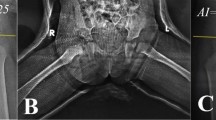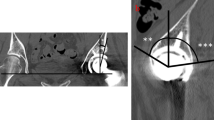Abstract
Introduction: Many reports have suggested that Chiari pelvic osteotomy would improve the results of acetabular component placement and fixation in subsequent total hip arthroplasty. However, little is known concerning the biomechanical, radiological, and clinical effects of Chiari pelvic osteotomy on subsequent total hip arthroplasty. Materials and methods: Ten total hip arthroplasties for developmental dysplasia of the hip after previous Chiari pelvic osteotomy (Chiari group) were compared with 20 total hip arthroplasties for developmental dysplasia of the hip without previous surgery (control group). Preoperative patient demographic data and operative technique were well matched between the groups. The mean duration of follow-up was 3.0 years. Biomechanical, radiological, and clinical evaluations were performed. Results: No acetabular or femoral components exhibited loosening. All patients had good or excellent clinical score according to the Merle d’Aubigne-Postel rating system at the most recent follow-up. Abductor force and joint force were smaller in the Chiari group, although long operative time, more blood loss, and verticalization of joint force were noted in this group. Conclusion: This limited study suggested that Chiari pelvic osteotomy changed the biomechanical features of the hip joint, and that this alteration might have compromised subsequent total hip arthroplasty.





Similar content being viewed by others
References
Andrew AS, Harris WH (1997) Bulk structural autogenous grafts and allografts for reconstruction of the acetabulum in total hip arthroplasty sixteen-year-average follow-up. J Bone Joint Surg Am 79:159–68
Chiari K (1974) Medial displacement osteotomy of the pelvis. Clin Orthop 98:55–71
Crowe JF, Mani VJ, Ranawat CS (1979) Total hip replacement in congenital dislocation and dysplasia of the hip. J Bone Joint Surg Am 61:15–23
d’Aubigne RM, Postel M (1954) Function al results of hip arthroplasty with acrylic prosthesis. J Bone Joint Surg Am 36:451–475
DeLee JG, Charnley J (1976) Radiological demarcation of cemented sockets in total hip replacement. Clin Orthop 121:20–32
Dunn HK, Hess WE (1976) Total hip reconstruction in chronically dislocated hips. J Bone Joint Surg Am 58:838–845
Engh CA, Bobyn JD, Glassman AH (1987) Porous-coated hip replacement. The factors governing bone ingrowth, stress shielding, and clinical results. J Bone Joint Surg Br 69:45–55
Fender D, van der Meulen JH, Gregg PJ (2003) Relationship between outcome and annual surgical experience for the charnley total hip replacement. Results from a regional hip register. J Bone Joint Surg Br 85:187–190
Graham S, Westin GW, Dawson E, Oppenheim WL (1986) The Chiari osteotomy. A review of 58 cases. Clin Orthop 208:249–258
Greenwald AS (1991) Biomechanics of the hip. In: Steinberg M (ed) The hip and its disorders. WB Saunders, Philadelphia p 49
Gruen TA, McNeice GM, Amstutz HC (1979) “Modes of failure” of cemented stem-type femoral components: a radiographic analysis of loosening. Clin Orthop Relat Res 141:17–27
Hamilton H, Fung T, Rapley P (2003) Related articles, reconstruction for chronic dislocation of the hip. J Bone Joint Surg Br 85:802–808
Hashemi-Nejad A, Haddad FS, Tong KM, Muirhead-Allwood SK, Catterall A (2002) Does Chiari osteotomy compromise subsequent total hip arthroplasty? J Arthroplasty 17:731–739
Herberts P, Malchau H (2000) Long-term registration has improved the quality of hip replacement: a review of the Swedish THR Register comparing 160,000 cases. Acta Orthop Scand 71:111–121
Hodgkinson JP, Shelley P, Wroblewski BM (1988) The correlation between the roentgenographic appearance and operative findings at the bone–cement junction of the socket in Charnley low friction arthroplasties. Clin Orthop 228:105–109
Hoffman DV, Simmons EH, Barrington TW (1974) The results of the Chiari osteotomy. Clin Orthop 98:162–170
Hogh J, Macnicol MF (1987) The Chiari pelvic osteotomy. A long-term review of clinical and radiographic results. J Bone Joint Surg Br 69:365–373
Iannotti JP, Balderston RA, Booth RE, Rothman RH, Cohn JC, Pickens G (1986) Aseptic loosening after total hip arthroplasty. Incidence, clinical significance, and etiology. J Arthroplasty 1:99–107
Kobayashi S, Saito N, Nawata M, Horiuchi H, Iorio R, Takaoka K (2003) Total hip arthroplasty with bulk femoral head autograft for acetabular reconstruction in developmental dysplasia of the hip. J Bone Joint Surg Am 85:615–621
Lack W, Windhager R, Kutschera HP, Engel A (1991) Chiari pelvic osteotomy for osteoarthritis secondary to hip dysplasia. Indications and long-term results. J Bone Joint Surg Br 73:229–234
Mitchell GP (1974) Chiari medial displacement osteotomy. Clin Orthop 98:146–150
Nercessian OA, Joshi RP, Martin G, Su BW, Eftekhar NS (2003) Influence of demographic and technical variables on the incidence of osteolysis in Charnley primary low-friction hip arthroplasty. J Arthroplasty 18:631–637
Ohashi H, Hirohashi K, Yamano Y (2000) Factors influencing the outcome of Chiari pelvic osteotomy: a long-term follow-up. J Bone Joint Surg Br 82:517–525
Pagnano W, Hanssen AD, Lewallen DG, Shaughnessy WJ (1996) The effect of superior placement of the acetabular component on the rate of loosening after total hip arthroplasty. J Bone Joint Surg Am 78:1004–1114
Roder C, Parvizi J, Eggli S, Berry DJ, Muller ME, Busato A (2003) Demographic factors affecting long-term outcome of total hip arthroplasty. Clin Orthop 417:62–73
Rodriguez JA, Huk OL, Pellicci PM, Wilson PD Jr (1995) Autogenous bone grafts from the femoral head for the treatment of acetabular deficiency in primary total hip arthroplasty with cement. Long-term results. J Bone Joint Surg Am 77:1227–1233
Russotti GM, Harris WH (1991) Proximal placement of the acetabular component in total hip arthroplasty. A long-term follow-up study. J Bone Joint Surg Am 73:587–592
Scher MA, Jakim I (1991) Combined intertrochanteric and Chiari pelvic osteotomies for hip dysplasia. J Bone Joint Surg Br 73:626–631
Shinar AA, Harris WH (1997) Bulk structural autogenous grafts and allografts for reconstruction of the acetabulum in total hip arthroplasty. Sixteen-year-average follow-up. J Bone Joint Surg Am 79:159–168
Author information
Authors and Affiliations
Corresponding author
Rights and permissions
About this article
Cite this article
Minoda, Y., Kadowaki, T. & Kim, M. Total hip arthroplasty of dysplastic hip after previous Chiari pelvic osteotomy. Arch Orthop Trauma Surg 126, 394–400 (2006). https://doi.org/10.1007/s00402-006-0141-6
Received:
Published:
Issue Date:
DOI: https://doi.org/10.1007/s00402-006-0141-6




